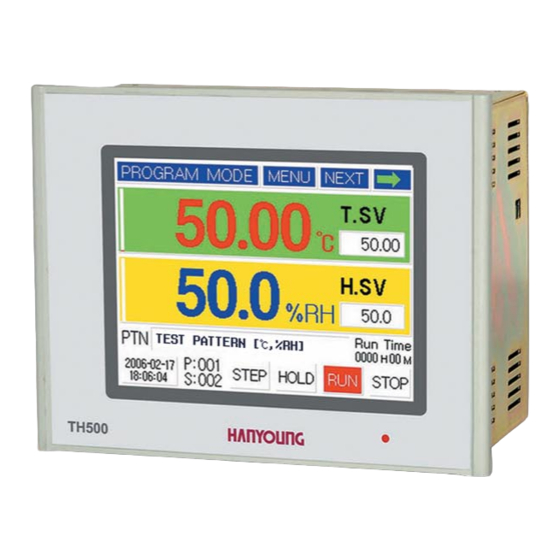
Table of Contents
Advertisement
Advertisement
Table of Contents

Summarization of Contents
1 Before Starting
1.1 Checking the Product
Verify model type and check for physical defects after purchase.
1.2 Safety Information
Details hazards like Danger, Warning, and Caution for safe operation and installation.
1.3 Quality Guarantee
Outlines warranty terms and conditions, including exclusions and repair policies.
2 Installation Method
2.1 How to Install
Step-by-step guide for panel mounting the controller using fixing brackets.
2.2 Suffix Code
Explains model variations based on TYPE, Input/Output boards, and language options.
2.3 Dimension and Panel Cutout
Provides detailed physical dimensions and panel cut-out specifications for TH500 and TH300 models.
2.4 Connection Diagram
Illustrates internal and external wiring diagrams for TH500 and TH300 models.
2.5 Communication Connection
Details RS232C and RS422/RS485 connection arrangements for device communication.
3 Setting and Operating
3.1 Initial Screen Display
Describes the sequence of screens displayed upon power-up, including Logo and System check.
3.2 Input Methods and Screens
Explains how to use input boxes, number input, and text entry modes on the controller.
3.3 Operating Screen Part Identification
Identifies and explains the function of each numbered component on the fixed control operating screen.
3.4 Fix Control Operation
Guides users on starting, stopping, and managing temperature/humidity control with fixed set values.
3.5 Program Control Operation
Details how to run and manage programs, including setting up patterns and segments.
3.6 PID Auto Tuning
Explains the automatic PID tuning process for optimizing control system performance.
3.7 Graph Display and Settings
Describes how to configure and view temperature and humidity data graphs.
3.8 Error Indication and History
Covers how errors are indicated on screen and how to view the operating record.
4 Displays
4.1 Operating Screen Overview
Introduces the three main display sections: Working, Function Setting, and System Setting.
4.2 Function Setting Display
Explains the menu for accessing function settings, composed of six buttons.
4.3 System Setting Screen
Details how to access and navigate the system setting menu, including password input.
5 Function Setting
5.1 Operation Setting
Configures operational parameters like RUN MODE, SV RATE, and FIX RUN TIME.
5.2 Program Setting
Covers setting up control patterns, segments, time signals, and alarms for program control.
5.3 Date/Time Reservation
Allows setting a future date and time for the controller to start an operation.
5.4 Graph and Save Settings
Configures graph display parameters, data logging, and storage conditions.
6 System Setting
6.1 Sensor Type Configuration
Sets up sensor types, input ranges, scaling, bias, and filter times for temperature and humidity.
6.2 Control Output Configuration
Configures temperature and humidity control output types, periods, directions, and ranges.
6.3 Retransmission Output Settings
Sets up temperature and humidity retransmission output signals, ranges, and burnout settings.
6.4 Inner Signal and Alarm Settings
Configures inner signals for temperature/humidity and system alarm parameters.
6.5 PID Setting
Defines PID zones, auto-tuning gains, and proportional/integral/derivative parameters for control loops.
6.6 Digital Input (D.I) Configuration
Assigns functions like RUN/STOP, STEP, HOLD to digital input points.
6.7 Digital Output (D.O) Configuration
Assigns system signals, time signals, and ON/OFF signals to relay or output collector.
6.8 Communication Setting
Configures serial communication parameters for RS232C, RS485/422, and USB.
6.9 ETC (Other) Settings
Covers miscellaneous settings like language, password, PV HOLD, and initialization.
7 Simple Example
7.1 Input Related Settings
Demonstrates sensor input setup for temperature and humidity, including range and correction.
7.2 Setting Output Parameters
Explains control and retransmission output settings for temperature and humidity.
7.3 Inner Signal Setup Example
Provides examples of controlling refrigerators and dehumidifiers using inner signals.
7.4 Fix Control Operation Example
Illustrates how to select and operate the fix control mode, including value setting.
7.5 Programmable Control Example
Guides users through selecting and operating program control, including pattern setup.
8 Specification
8.1 Input Specifications
Details input types, ranges, accuracy, and contact inputs for TH500/TH300.
8.2 Output Specifications
Lists specifications for control, retransmission, and digital outputs (Relay, Transistor).
8.5 Product Functions Overview
Summarizes key functions including PID control, Auto Tuning, and alarm types.
8.6 Touch LCD Specifications
Details the specifications of the touch LCD display for both models.
8.7 Operation Environment
Specifies environmental conditions for usable temperature, humidity, storage, vibration, and shock.
9 ACCESSORIES (Sold Separately)
9.1 EM310 USB Memory Specification
Lists the specifications for the EM310 USB memory storage device.
9.2 EM310 Name of Each Part
Identifies the components and buttons on the EM310 USB memory device.
9.3 EM310 Dimension and Panel Cutout
Provides physical dimensions and panel cut-out details for the EM310 device.
9.4 EM310 Connection Diagram
Shows the connection diagram between TH500/TH300 and the EM310 device.



Need help?
Do you have a question about the TH300 and is the answer not in the manual?
Questions and answers